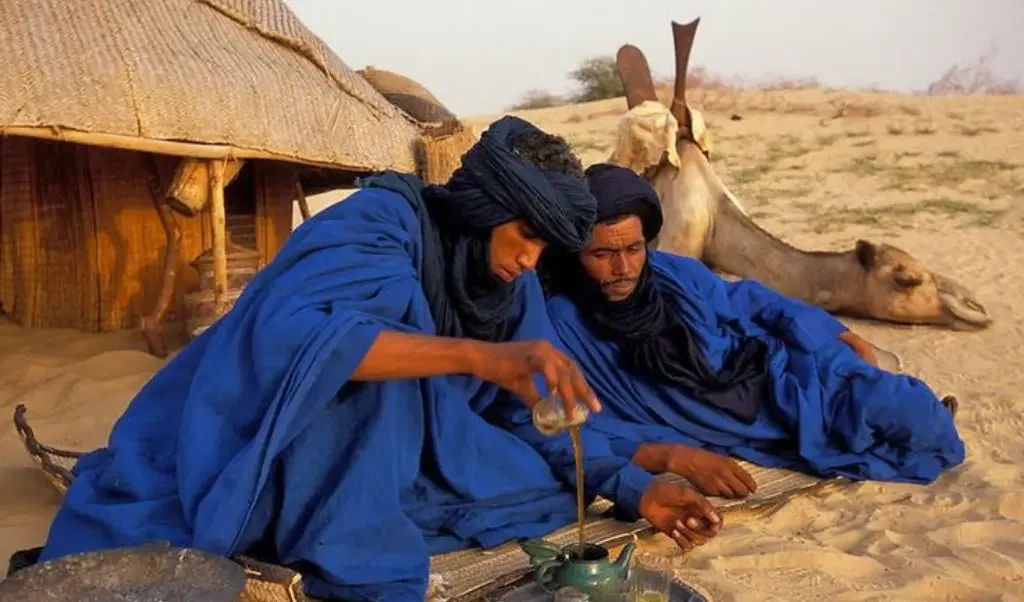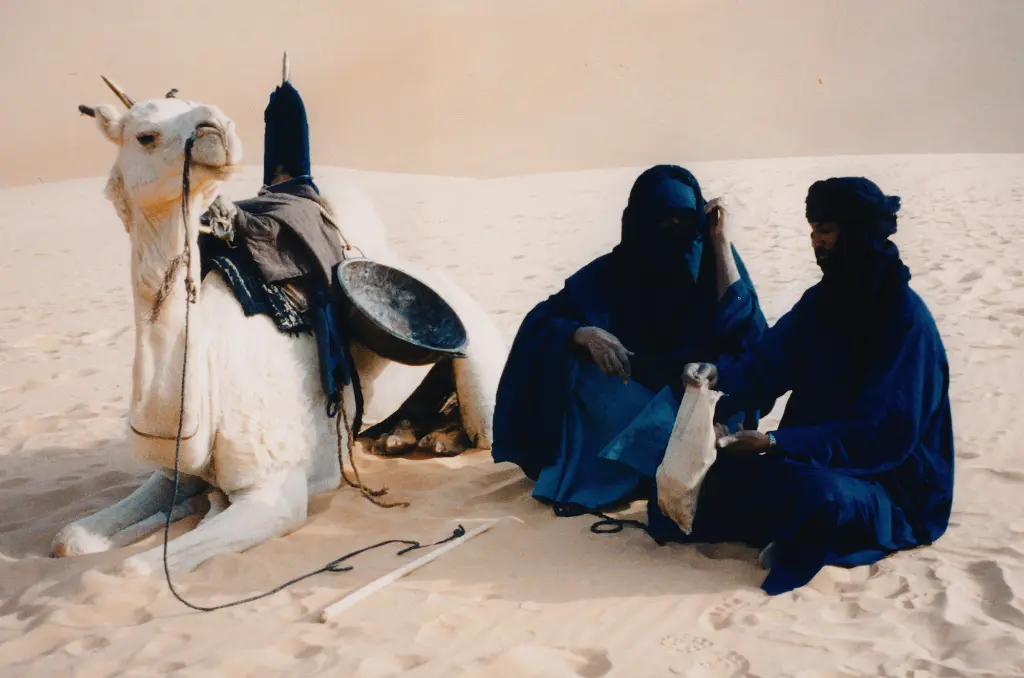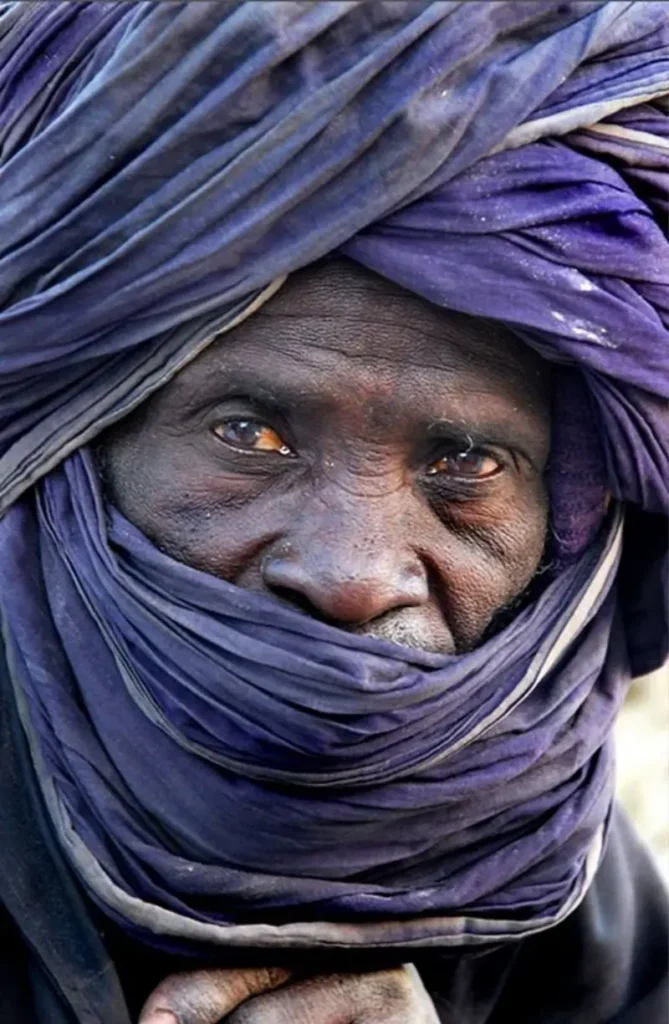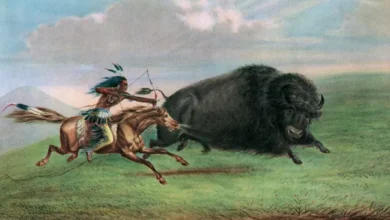Hey there! Imagine a vast sea of golden sand stretching endlessly under a blazing sun, punctuated by striking figures draped in flowing indigo robes.
These are the Tuareg, a nomadic people of the Sahara Desert whose vibrant blue attire has earned them the nickname “Blue Men of the Sahara.” But there’s so much more to their story than just a cool color. The Tuareg indigo mystique isn’t just about fashion—it’s a window into a rich cultural identity shaped by the desert, history, and resilience. In this article, we’re diving deep into how this iconic desert blue weaves together tradition, practicality, and pride for the Tuareg people. Ready? Let’s explore!
Who Are the Tuareg? A Quick Introduction
First things first—who are these fascinating folks? The Tuareg are a nomadic people of Berber descent, roaming the vast Sahara across countries like Mali, Niger, Algeria, Libya, and Burkina Faso. With an estimated population of about 1.2 million, they’ve called the desert home for centuries, possibly even millennia.

Their origins are a bit hazy, but some historians link them to the ancient Garamantes, a Berber group from the Roman era. What’s clear is that the Tuareg have thrived in one of the harshest environments on Earth, mastering the art of survival through pastoralism, trade, and sheer adaptability.
See also The Maasai: Semi-Nomadic Pastoralists of Kenya and Tanzania
The Maasai: Semi-Nomadic Pastoralists of Kenya and TanzaniaUnlike many North African groups influenced heavily by Arab culture, the Tuareg have clung to their distinct identity. They speak Tamasheq, a Berber language with its own ancient script called Tifinagh, and their society is steeped in traditions that set them apart. But what really catches the eye—and the imagination—is their indigo-dyed clothing. It’s not just a style statement; it’s a symbol of who they are. Let’s unpack that next.
The Magic of Indigo: More Than Just a Color
Picture this: you’re trudging through the Sahara, the sun beating down mercilessly. You’d want something to shield you, right? Enter the Tuareg’s indigo robes, known as tagelmusts or chèches. These long, flowing garments (often wrapped around the head and face) are dyed a deep, rich blue using the leaves of the indigo plant. The dye is pounded and soaked to create a pigment so intense it sometimes rubs off on their skin, giving them that “Blue Men” moniker.

But why indigo? For one, it’s practical. The dark color offers UV protection, absorbing the sun’s harsh rays and keeping the wearer cooler in the scorching heat. Plus, the loose fabric billows around the body, letting air circulate while blocking sand and wind (crucial in a desert where sandstorms can whip up out of nowhere. Some say the face veils (worn by men, not women) more on that later) even started as a shield against desert grit or a way to hide tribal identities in risky territory.
Beyond practicality, though, indigo carries a deeper vibe. Historically, it was a prized dye across Africa, linked to wealth and status because of the skill and time it took to make. For the Tuareg, wearing it became a badge of honor, a way to stand out against the amber sands. It’s like their version of a cultural uniform—functional, beautiful, and loaded with meaning.
See also The Ainu: An Indigenous People of Japan and Russia
The Ainu: An Indigenous People of Japan and RussiaA Peek Into Tuareg Society: Tradition Meets Resilience
To really get the indigo mystique, we need to zoom into Tuareg life. Their society is a tapestry of customs that’s both unique and surprisingly progressive in some ways. Unlike many Muslim cultures in the region, the Tuareg are matrilineal, meaning lineage and inheritance often pass through the mother’s side. Women hold a respected place they don’t veil their faces, manage households, and even keep their property after divorce. Pretty cool, right?

Men, on the other hand, don the tagelmust around age 18 as a rite of passage into manhood. It’s not just about protection; it’s said to ward off evil spirits, a nod to pre-Islamic beliefs that still linger in their blend of Islam. The Tuareg follow the Maliki sect of Islam, introduced centuries ago, but they’ve kept some older traditions alive, like wearing amulets with Quranic verses or sacred objects.
Their social structure is layered too. There are nobles, religious leaders, craftsmen, and vassal tribes, all organized into clans called tawsheten, led by a chief called an amghar. Several clans might unite under an amenokal, forming a larger confederation. It’s a system built for flexibility—perfect for a nomadic life where you’re always on the move with your camels, goats, and sheep.
Desert Blue in Daily Life: Clothing and Craftsmanship
Let’s talk style. The Tuareg wardrobe is all about those indigo robes, but it’s not just the men who shine. Women rock vibrant dresses and ornate jewelry—think silver pendants, bracelets, and the famous Cross of Agadez, a symbol of their heritage. While men’s tagelmusts are the indigo stars, women often wear lighter fabrics with intricate patterns, steering clear of gold (they’ve got a superstitious thing about it) and favoring silver instead.

The process of making these garments is an art form. Crafting natural indigo takes years to master—it’s a bacterial fermentation process that turns leaves into a dye vat, then into that stunning blue. Archaeological finds, like textiles from Mali’s Bandiagara caves dating back to the 11th century, show how long this tradition has been around. Today, though, synthetic dyes are creeping in, a practical shift that some artisans lament as they push for a “real indigo” label.
This craftsmanship spills over into other areas too. Tuareg smiths create gorgeous silver jewelry and leather goods—purses, saddles, you name it—often decorated with tribal motifs. It’s all part of the desert blue aesthetic: bold, practical, and unmistakably Tuareg.
The Sahara’s Influence: How the Desert Shapes Identity
The Sahara isn’t just a backdrop for the Tuareg—it’s a character in their story. This massive desert, stretching over 3.6 million square miles, has molded their lifestyle and their cultural identity. As nomads, they’ve followed seasonal routes for grazing and water, crisscrossing modern borders that mean little to them. Their name for themselves—Imuhagh, meaning “the free people”—says it all: they’re tied to the land, not to nations.
The indigo mystique ties into this too. That blue stands out against the monotonous sand, a visual shout of resilience and presence. It’s no wonder outsiders have romanticized them as “knights of the desert” or “men from nowhere.” Their oral traditions—poetry, songs, and stories passed down by firelight—celebrate this bond with the desert. Music, played on instruments like the imzad (a one-stringed violin) and tende drum, echoes across the dunes, carrying tales of love, loss, and survival.
For centuries, the Tuareg were also key players in the trans-Saharan trade, moving salt, gold, and spices on camel caravans. Their blue robes became a trademark along routes like the Taghaza Trail, linking oasis towns from Morocco to Sierra Leone. The desert gave them purpose—and their indigo gave them swagger.

Challenges to the Mystique: Modern Times and Change
Now, let’s shift gears. The Tuareg indigo mystique is timeless, but the world around it isn’t. The 20th and 21st centuries have thrown some curveballs their way. Climate change has made the Sahara drier, shrinking grazing lands and water sources. Droughts in the 1970s and ‘80s forced many Tuareg to flee to Libya or Algeria, only to return later with military skills—and unrest.
Then there’s politics. Colonial borders carved up their territory, and post-independence governments in Mali and Niger haven’t always played nice. Tuareg rebellions—like those in the 1990s and 2012—stemmed from fights for autonomy and a slice of the region’s mineral wealth (think uranium in Niger). Violence and groups like Al Qaeda in the Islamic Maghreb have scared off tourists, a lifeline for selling crafts and sharing their culture.
Many Tuareg have traded nomadism for settled life in oasis towns like Zagora or Timbuktu. With that shift, the desert blue lifestyle—once defined by constant motion—is evolving. Some worry the mystique might fade as younger generations embrace cities and tech. But don’t count them out yet—the Tuareg have a knack for adapting while holding onto what matters.
Indigo as Identity: A Symbol That Endures
So, what’s the big deal with indigo in all this? It’s more than a dye—it’s a thread tying the Tuareg to their past, present, and future. That deep blue embodies their cultural identity: freedom, resilience, and a connection to the Sahara. When a Tuareg man wraps his tagelmust or a woman dons her silver jewelry, they’re not just dressing up—they’re declaring who they are.
Outsiders have long been fascinated by this. From French colonial tales to modern fashion (think Hermès commissioning Tuareg-inspired silver in the ‘90s), the indigo mystique has a global pull. Festivals like Mali’s Festival in the Desert showcase their music and dance, while tourism—when it’s safe—lets travelers glimpse their world. Even today, in Mauritania, the blue daraa tunic stays trendy, a nod to Tuareg influence.
Yet, for the Tuareg themselves, it’s personal. The indigo isn’t just for show—it’s a lived tradition, a practical choice, and a proud marker of belonging. As one artisan put it, it’s about wearing their story on their sleeves—literally.
Preserving the Mystique: What’s Next for the Tuareg?

Looking ahead, the Tuareg face a balancing act. How do you keep the desert blue alive in a world of smartphones and synthetic dyes? For some, it’s about doubling down on tradition—teaching kids Tamasheq, crafting natural indigo, or singing those old songs. Others see opportunity in sharing their culture, whether through jewelry sales or cultural tours.
The challenges are real—desertification, poverty, and conflict aren’t going away overnight. But the Tuareg have survived worse. Their history is a testament to adaptability, from dodging Roman legions to outlasting French rule. That indigo mystique isn’t just a relic; it’s a living, breathing part of who they are, ready to evolve with them.
For us, appreciating it means more than snapping a photo of a blue-robed nomad. It’s about understanding the depth behind the color—the desert grit, the ancient trade routes, the quiet strength of a people who’ve made the impossible their home. The Tuareg remind us that identity isn’t static; it’s a story dyed into every fiber, as vibrant and enduring as their indigo.
Wrapping It Up: The Lasting Glow of Desert Blue
So, there you have it—the Tuareg indigo mystique in all its glory. From the practical genius of UV-blocking robes to the cultural pride stitched into every blue thread, this desert hue defines the Tuareg in ways that go beyond the surface. It’s a symbol of survival, a splash of beauty in a harsh world, and a link to a heritage that refuses to fade.
Next time you hear about the “Blue Men of the Sahara,” you’ll know there’s a whole universe behind that nickname. The Tuareg’s desert blue isn’t just a color—it’s a way of life, a mystique that’s as captivating as the dunes themselves. What do you think—pretty amazing, huh? Let’s keep celebrating these stories that make our world so wonderfully diverse.




